Return of a Legend: The AKG C451B
You put a mic on an instrument and say, “Oh, yeah. That’s it. That’s the sound!”
Have you ever experienced this?
The Heritage
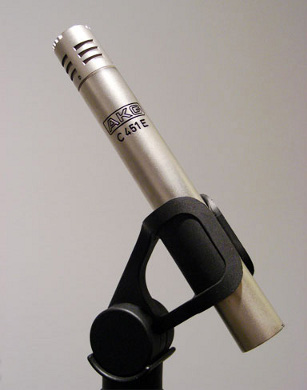 Over the years there have been some archetypal mics that have become the studio standard for certain tasks. The Neumann U47 large diaphragm mic used for solo vocals comes to mind. Though it was created to allow a single mic to pick up both an orchestra and a vocal soloist, its characteristic presence peak has become a favorite sound, making it a go-to mic for studio vocals. So it was with the AKG C451 modular small diaphragm condenser mic system. When it debuted in the late 1960s, the Condenser Microphone System from AKG consisted of a system of preamp bodies, interchangeable capsules, and accessories including pad and roll-off modules that allowed it to serve many different functions. The basis of the mic was the series of externally-biased capsules with phantom powered preamp bodies. This mic quickly became a favorite for acoustic guitar amongst recording engineers and producers. Specifically, the combination of the C-451 E phantom powered preamp and the CK1 cardioid capsule, with their smooth, gentle, upper-end bump, formed a favorite instrument to make a dull acoustic guitar shimmer and cut through a full mix. In fact, between the C451E and the Neumann KM-84 small diaphragm condenser, the sound of acoustic guitar in popular recording was defined for two decades. The 451 also provided a lovely, brilliant cymbal sound when used as an overhead mic or high-hat mic, and a very snappy snare sound as well. I’ve got a favorite recording of mine from 1981 with C451Es on the overheads where the cymbals and cymbal bells are simply brilliant. All of my colleagues who hear them express amazement at the crisp and intimate sound they gave the cymbals.
Over the years there have been some archetypal mics that have become the studio standard for certain tasks. The Neumann U47 large diaphragm mic used for solo vocals comes to mind. Though it was created to allow a single mic to pick up both an orchestra and a vocal soloist, its characteristic presence peak has become a favorite sound, making it a go-to mic for studio vocals. So it was with the AKG C451 modular small diaphragm condenser mic system. When it debuted in the late 1960s, the Condenser Microphone System from AKG consisted of a system of preamp bodies, interchangeable capsules, and accessories including pad and roll-off modules that allowed it to serve many different functions. The basis of the mic was the series of externally-biased capsules with phantom powered preamp bodies. This mic quickly became a favorite for acoustic guitar amongst recording engineers and producers. Specifically, the combination of the C-451 E phantom powered preamp and the CK1 cardioid capsule, with their smooth, gentle, upper-end bump, formed a favorite instrument to make a dull acoustic guitar shimmer and cut through a full mix. In fact, between the C451E and the Neumann KM-84 small diaphragm condenser, the sound of acoustic guitar in popular recording was defined for two decades. The 451 also provided a lovely, brilliant cymbal sound when used as an overhead mic or high-hat mic, and a very snappy snare sound as well. I’ve got a favorite recording of mine from 1981 with C451Es on the overheads where the cymbals and cymbal bells are simply brilliant. All of my colleagues who hear them express amazement at the crisp and intimate sound they gave the cymbals.
But when the digital age dawned, there were cries in the trade journals that mics with presence peaks were contributing all sorts of overtone hash to recordings in a new digital medium that didn’t tame the high frequencies by naturally rolling them off, as the analog medium did. Mic manufacturers scrambled to create new product lines eliminating the presence peaks. At the same time, new manufacturing techniques lowered the cost of fabrication and mic prices began to drop. So it was with AKG, who released their C460 line to cater to the new aesthetic. I, for one, never really “bonded” with the C460 – it sounded too much like a Shure SM-81, which is a fine mic in its own right but in an attempt to have a flatter response, doesn’t offer the shimmer of the original AKG instrument. As a result, between internal model competition, changes in tastes, and manufacturing trends creating more inexpensive intruments, the C451E was discontinued in 1994 for economic reasons. As it turns out, however, it wasn’t simply relegated to the scrap heap of time…
Resurgence
Meanwhile, the desirability of the older mics with presence peaks, and of the AKG C451E in particular, never waned amongst professional users. Excellent recordings, lauded for their distinct, clear sound, continued to be made by the top producers and engineers in the business using these mics. A back channel that traded in the older mics remained and grew. Most studios kept theirs and continued to use them. In the late 1990s, a ground swell of popular interest drove AKG to rethink their decision to end production of their classic microphone, and to move toward a recreation. At their headquarters in Vienna, Austria, AKG gathered twelve excellent examples of the CK1 capsule and re-engineered it as an electret element. Then, taking advantage of modern surface-mount technology which allows machine assembly with predictable, reliable results, they redesigned the C451E preamp, eliminating the output transformer and lowering the self-noise while somehow maintaining the sound of the original package. They also decided to integrate low frequency roll off and pre-attenuation pad switches into the body of the mic. These were originally offered as screw-in accessory modules to go between the preamp and capsule. While this original design offered the ultimate in fleixiblity and signal purity, it introduced a finely-pitched screw joint that proved to be less than reliable in road use. In order to make the package more robust, AKG's designers eliminated the finely threaded connection between body and capsule and permanently attached the capsule to the body. As a result, the mic can now withstand AKG’s six-foot drop test and handle humidity and temperature changes as well, making it more attractive for PA and remote applications. Released in 2004, the resulting model, the C451B, has marvelouslyly brought back the sound of the original mic in a more durable package but at a price point that can compete against the current flood of inexpensive, reverse-engineered, Chinese-built mics. AKG somehow manages to pull this off while continuing to manufacture their microphones in Vienna, Austria.
A back channel that traded in the older mics remained and grew. Most studios kept theirs and continued to use them. In the late 1990s, a ground swell of popular interest drove AKG to rethink their decision to end production of their classic microphone, and to move toward a recreation. At their headquarters in Vienna, Austria, AKG gathered twelve excellent examples of the CK1 capsule and re-engineered it as an electret element. Then, taking advantage of modern surface-mount technology which allows machine assembly with predictable, reliable results, they redesigned the C451E preamp, eliminating the output transformer and lowering the self-noise while somehow maintaining the sound of the original package. They also decided to integrate low frequency roll off and pre-attenuation pad switches into the body of the mic. These were originally offered as screw-in accessory modules to go between the preamp and capsule. While this original design offered the ultimate in fleixiblity and signal purity, it introduced a finely-pitched screw joint that proved to be less than reliable in road use. In order to make the package more robust, AKG's designers eliminated the finely threaded connection between body and capsule and permanently attached the capsule to the body. As a result, the mic can now withstand AKG’s six-foot drop test and handle humidity and temperature changes as well, making it more attractive for PA and remote applications. Released in 2004, the resulting model, the C451B, has marvelouslyly brought back the sound of the original mic in a more durable package but at a price point that can compete against the current flood of inexpensive, reverse-engineered, Chinese-built mics. AKG somehow manages to pull this off while continuing to manufacture their microphones in Vienna, Austria.
The Sound
So, how does it sound? Well, the first time I put up mine in front of a guitar, my reaction was the one above, “Oh, yeah. That’s it. That’s the sound I remember.” The mic has a very neutral, smooth, flat midrange and a very pretty presence rise of about three db starting at 5khz that flatters just about any acoustic guitar. It shines at bringing out the upper end on the typical boxy, full-sounding Martin, and that's how it made its name. It reproduces a classical guitar with amazing clarity, offering a great attack and individual string definition. It does the “super-real, bigger than life, brighter than life, more sparkly than life” thing marvelously. It also effortlessly brings out a guitar in an ensemble situation. It handles all of these situations pretty much with little or no added top-end EQ. The mic's very even off-axis response makes any bleed from around the sides of the mic easy to deal with in a mix. How does it stack up against the venerable C451E? Well, as a matter of fact, I have access to a pair of C451Es at the studio where I work so I was able to compare this mic to them and bring in some colleagues for their opinions as well. For mics built thirty years apart, I found the resemblance phenomenal. I am pleased to be able to report that the new mic preserves every bit of the character and "prettiness" of the originals, but shows that it is transformerless by the additional very-high-end clarity and dynamic response that it possesses. When I paired the new mic with an original in a co-incident pair and recorded classical and steel guitars at close range, it was difficult to tell them apart. However, my colleagues and I were, in fact, able to tell them apart in blind tests based upon the difference in the very-high-frequency response. Everyone thought both were pretty sounding but the terms used to differentiate between them were "rounder high frequencies" for the originals and "more modern", "more high-end clarity" for the new C451B. 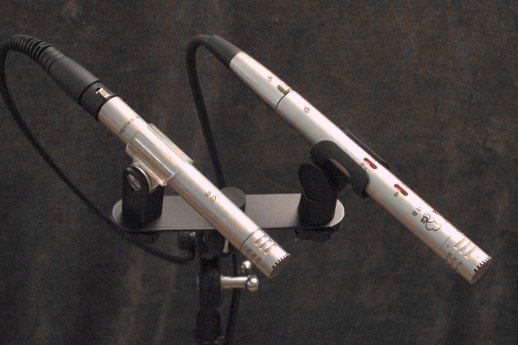 I found that I consistently preferred to put the newer C451B on the right of a pair where we humans tend to prefer any extra high-end activity to go, but the difference really was fairly inconsequential. Of course, if you are looking for a mic without a presence peak, this isn't it. Straight-wire people and those who either prefer not to EQ or don't have access to EQ, take note: If you want a perfectly flat high end, you'll probably have to bring in the presence peak with EQ. However, with that said, as a test, I brought my wife by my mix position to listen to a couple of trial tracks I recorded with the mic. She was rather amazed at the classic, professional sound it immediately imparted to these little home trial recordings, and she's heard twenty-eight years worth of my recordings from both home and studio. So, there you go, it earns that all-important distaff endorsement: Chicks will dig your skills if you record with one of these. Need I say more?
I found that I consistently preferred to put the newer C451B on the right of a pair where we humans tend to prefer any extra high-end activity to go, but the difference really was fairly inconsequential. Of course, if you are looking for a mic without a presence peak, this isn't it. Straight-wire people and those who either prefer not to EQ or don't have access to EQ, take note: If you want a perfectly flat high end, you'll probably have to bring in the presence peak with EQ. However, with that said, as a test, I brought my wife by my mix position to listen to a couple of trial tracks I recorded with the mic. She was rather amazed at the classic, professional sound it immediately imparted to these little home trial recordings, and she's heard twenty-eight years worth of my recordings from both home and studio. So, there you go, it earns that all-important distaff endorsement: Chicks will dig your skills if you record with one of these. Need I say more?
UPDATE 08-14-09
Okay, I will say something more: Since my original review, I've been commuting my pair of 451Bs to the studio and using them for all sorts of cool recording tasks. I've found the 451B to be especially adept at micing high-hats, ride cymbals, and shakers, where you want a present sound that is at the same time very smooth. The ride cymbals, in particular, just have this lovely, brassy sound with lots of ring, but still a pretty sound. It just makes things cut through without being harsh or brash. I've also loved them for recording strummed acoustic guitar for use in a combo. With just a little bit of the lower-mid fullness rolled off, the highs chirp through very prettily. They aren't horribly picky about positioning either: I can quickly throw up a co-incident array and get a nice stereo picture that both reduces well to mono and spreads nicely across the stereo field. Through experience these mics have proven extremely useful. So much, in fact, that I asked my manager to order a matched pair for the studio.
SECOND UPDATE 09-12-09
This week I was able to use the AKG 451Bs extensively to record a string quartet. I chose to moderately closely-mic the instruments with a primary array of four Neumann TLM-170 microphones but was concerned that I wouldn't get enough "air" from the room to give a pleasant sound. To give me some more sound options, I decided to run a secondary array, more distant than the primary, as both a back-up and a secondary source to allow me to mix in more room sound. To beat the distance effect I needed a mic with a presence rise. Amongst a bunch of other possibilities, I decided to go with a newly-ordered matched pair of AKG 451Bs we were expecting to arrive at the studio, because of their nice, smooth upper-end. Sadly, the order didn't arrive in time for the sessions so I fell back on my own pair again and commuted them to the studio. I placed the 451Bs six-and-a-half feet up and five feet back in an ORTF array, spaced 7" apart and angled 110' from center. I ran each of the primary-array TLM-170s to its own track and the secondary pair to a stereo track. We did nine passes so that came to a total of forty-five tracks of string overdubs.
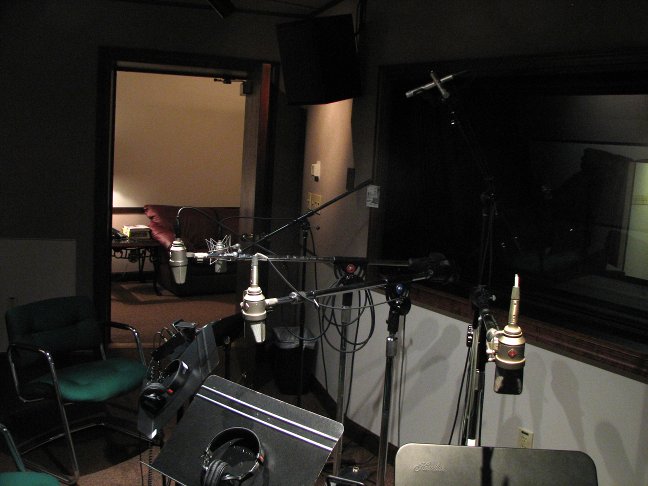
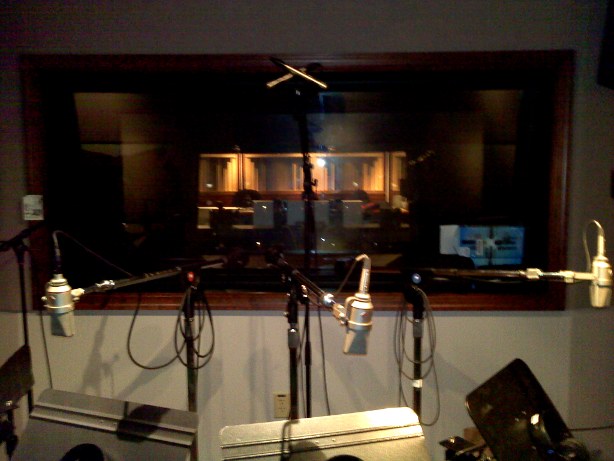

The results from both arrays were spectacular. The sound from the 451Bs was clear and clean with a smooth, pretty upper-end. I would have been happy to use those tracks alone because I was so happy with their sound. As planned, the ORTF array provided a consistent stereo field that spread beyond the speakers. I was very pleased with how smoothly the 451Bs created this soundfield and reproduced what I was seeing through the studio window. Because these recordings were overdubs for an indie-pop combo recording and not a solo performance, the individual instruments needed to be re-balanced dynamically from their natural levels using the TLM-170 tracks. In the end, the ORTF array worked marvelously as the "air" for the tighter mics.
Update 10/18/09
Here are the results of the above sessions: In the following clip, the hi-hat, ride, shaker, acoustic guitar, and the string overdub "air" are all recorded with the C451Bs. Clip copyright 2009 a Cry For peace.
Stolen Innocence
****
Here is a two-minute sample edited up from excerpts from three recordings:
1. Le Clochard, the Bread, written by Jan Akkerman of Focus. Classical guitar recorded mono using one C451B (new version) mixed with stereo synth. Mic controls set flat, low-end proximity effect rolled off and two DB of high-end shelving added at 10k hz. Mic pointed at neck/body joint, seven inches out.
2. Le Clochard, the Bread, written by Jan Akkerman of Focus. Classical guitar recorded stereo using one C451B (new version, panned right) and one '70s vintage C451E (left). Mics are configured as a coincident pair at 90' with centerline of array pointed at neck/body joint, seven inches out. Low-end build-up from proximity rolled out with a stereo EQ.
3. My Faith Looks Up to Thee, written by Ray Palmer/Lowell Mason. Dreadnought Taylor 710 recorded stereo using one C451B (new version, panned right) and one '70s vintage C451E (left). Mics are configured as a coincident pair at 90' with centerline of array pointed at neck/body joint, ten inches out. Quite a bit of low-end build-up from proximity rolled out with a stereo EQ. This still sounds a little close to my ears.
THE CLIP
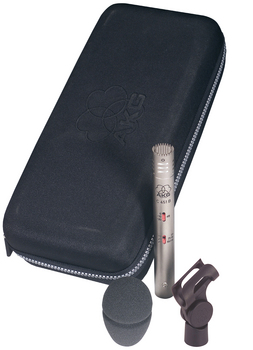
What's in the Package?
The AKG C451B is available in nickel-satin finish with engraved black lettering. The microphone comes with a semi-soft side, foam-lined zipper carrying case, a stand adapter, a windscreen, and instructions. Also included is a response plot sheet record for the individual microphone in the package. The C451B is also available in computer matched pairs (model C451 B/ST), matched to within one db and packed in a hard shell carring case with a stereo mounting bar. The mic functions on phantom power between nine and fifty-two volts, DC. The on board pre-attenuation pad switches between 0, -10db, and -20 db of attenuation. The twelve-db-per-octave bass roll-off network switches between flat and -12 db down points at 75hz and 150hz. Both switches have bold, high-contrast orange background material to make them easy to read. The C451B features self noise of 18 db-A and a sensitivity of 9mv/Pa(-41dbv). The mic itself is .75" in diameter and 6.3" long. With the accessories and packaging it weighs 1.7 pounds. AKG warrants the mic to the original owner for two years. The manufacturer's suggested retail price is $689 but the mic “streets” at about $569 at typical discount houses.

Published plot for AKG C451B as a class
AKG ACOUSTICS HOME
= =
=



 Over the years there have been some archetypal mics that have become the studio standard for certain tasks. The Neumann U47 large diaphragm mic used for solo vocals comes to mind. Though it was created to allow a single mic to pick up both an orchestra and a vocal soloist, its characteristic presence peak has become a favorite sound, making it a go-to mic for studio vocals. So it was with the AKG C451 modular small diaphragm condenser mic system. When it debuted in the late 1960s, the Condenser Microphone System from AKG consisted of a system of preamp bodies, interchangeable capsules, and accessories including pad and roll-off modules that allowed it to serve many different functions. The basis of the mic was the series of externally-biased capsules with phantom powered preamp bodies. This mic quickly became a favorite for acoustic guitar amongst recording engineers and producers. Specifically, the combination of the C-451 E phantom powered preamp and the CK1 cardioid capsule, with their smooth, gentle, upper-end bump, formed a favorite instrument to make a dull acoustic guitar shimmer and cut through a full mix. In fact, between the C451E and the Neumann KM-84 small diaphragm condenser, the sound of acoustic guitar in popular recording was defined for two decades. The 451 also provided a lovely, brilliant cymbal sound when used as an overhead mic or high-hat mic, and a very snappy snare sound as well. I’ve got a favorite recording of mine from 1981 with C451Es on the overheads where the cymbals and cymbal bells are simply brilliant. All of my colleagues who hear them express amazement at the crisp and intimate sound they gave the cymbals.
Over the years there have been some archetypal mics that have become the studio standard for certain tasks. The Neumann U47 large diaphragm mic used for solo vocals comes to mind. Though it was created to allow a single mic to pick up both an orchestra and a vocal soloist, its characteristic presence peak has become a favorite sound, making it a go-to mic for studio vocals. So it was with the AKG C451 modular small diaphragm condenser mic system. When it debuted in the late 1960s, the Condenser Microphone System from AKG consisted of a system of preamp bodies, interchangeable capsules, and accessories including pad and roll-off modules that allowed it to serve many different functions. The basis of the mic was the series of externally-biased capsules with phantom powered preamp bodies. This mic quickly became a favorite for acoustic guitar amongst recording engineers and producers. Specifically, the combination of the C-451 E phantom powered preamp and the CK1 cardioid capsule, with their smooth, gentle, upper-end bump, formed a favorite instrument to make a dull acoustic guitar shimmer and cut through a full mix. In fact, between the C451E and the Neumann KM-84 small diaphragm condenser, the sound of acoustic guitar in popular recording was defined for two decades. The 451 also provided a lovely, brilliant cymbal sound when used as an overhead mic or high-hat mic, and a very snappy snare sound as well. I’ve got a favorite recording of mine from 1981 with C451Es on the overheads where the cymbals and cymbal bells are simply brilliant. All of my colleagues who hear them express amazement at the crisp and intimate sound they gave the cymbals. A back channel that traded in the older mics remained and grew. Most studios kept theirs and continued to use them. In the late 1990s, a ground swell of popular interest drove AKG to rethink their decision to end production of their classic microphone, and to move toward a recreation. At their headquarters in Vienna, Austria, AKG gathered twelve excellent examples of the CK1 capsule and re-engineered it as an electret element. Then, taking advantage of modern surface-mount technology which allows machine assembly with predictable, reliable results, they redesigned the C451E preamp, eliminating the output transformer and lowering the self-noise while somehow maintaining the sound of the original package. They also decided to integrate low frequency roll off and pre-attenuation pad switches into the body of the mic. These were originally offered as screw-in accessory modules to go between the preamp and capsule. While this original design offered the ultimate in fleixiblity and signal purity, it introduced a finely-pitched screw joint that proved to be less than reliable in road use. In order to make the package more robust, AKG's designers eliminated the finely threaded connection between body and capsule and permanently attached the capsule to the body. As a result, the mic can now withstand AKG’s six-foot drop test and handle humidity and temperature changes as well, making it more attractive for PA and remote applications. Released in 2004, the resulting model, the C451B, has marvelouslyly brought back the sound of the original mic in a more durable package but at a price point that can compete against the current flood of inexpensive, reverse-engineered, Chinese-built mics. AKG somehow manages to pull this off while continuing to manufacture their microphones in Vienna, Austria.
A back channel that traded in the older mics remained and grew. Most studios kept theirs and continued to use them. In the late 1990s, a ground swell of popular interest drove AKG to rethink their decision to end production of their classic microphone, and to move toward a recreation. At their headquarters in Vienna, Austria, AKG gathered twelve excellent examples of the CK1 capsule and re-engineered it as an electret element. Then, taking advantage of modern surface-mount technology which allows machine assembly with predictable, reliable results, they redesigned the C451E preamp, eliminating the output transformer and lowering the self-noise while somehow maintaining the sound of the original package. They also decided to integrate low frequency roll off and pre-attenuation pad switches into the body of the mic. These were originally offered as screw-in accessory modules to go between the preamp and capsule. While this original design offered the ultimate in fleixiblity and signal purity, it introduced a finely-pitched screw joint that proved to be less than reliable in road use. In order to make the package more robust, AKG's designers eliminated the finely threaded connection between body and capsule and permanently attached the capsule to the body. As a result, the mic can now withstand AKG’s six-foot drop test and handle humidity and temperature changes as well, making it more attractive for PA and remote applications. Released in 2004, the resulting model, the C451B, has marvelouslyly brought back the sound of the original mic in a more durable package but at a price point that can compete against the current flood of inexpensive, reverse-engineered, Chinese-built mics. AKG somehow manages to pull this off while continuing to manufacture their microphones in Vienna, Austria. I found that I consistently preferred to put the newer C451B on the right of a pair where we humans tend to prefer any extra high-end activity to go, but the difference really was fairly inconsequential. Of course, if you are looking for a mic without a presence peak, this isn't it. Straight-wire people and those who either prefer not to EQ or don't have access to EQ, take note: If you want a perfectly flat high end, you'll probably have to bring in the presence peak with EQ. However, with that said, as a test, I brought my wife by my mix position to listen to a couple of trial tracks I recorded with the mic. She was rather amazed at the classic, professional sound it immediately imparted to these little home trial recordings, and she's heard twenty-eight years worth of my recordings from both home and studio. So, there you go, it earns that all-important distaff endorsement: Chicks will dig your skills if you record with one of these. Need I say more?
I found that I consistently preferred to put the newer C451B on the right of a pair where we humans tend to prefer any extra high-end activity to go, but the difference really was fairly inconsequential. Of course, if you are looking for a mic without a presence peak, this isn't it. Straight-wire people and those who either prefer not to EQ or don't have access to EQ, take note: If you want a perfectly flat high end, you'll probably have to bring in the presence peak with EQ. However, with that said, as a test, I brought my wife by my mix position to listen to a couple of trial tracks I recorded with the mic. She was rather amazed at the classic, professional sound it immediately imparted to these little home trial recordings, and she's heard twenty-eight years worth of my recordings from both home and studio. So, there you go, it earns that all-important distaff endorsement: Chicks will dig your skills if you record with one of these. Need I say more?



